|
|
|
Sort Order |
|
|
|
Items / Page
|
|
|
|
|
|
|
| Srl | Item |
| 1 |
ID:
148036


|
|
|
|
|
| Summary/Abstract |
This article examines how civilian defense militias shape violence during civil war. We define civilian defense forces as a sedentary and defensive form of pro-government militia that incumbents often use to harness the participation of civilians during a counterinsurgency campaign. We argue that civilian defense forces reduce the problem of insurgent identification. This leads to a reduction in state violence against civilians. However, we also claim that these actors undermine civilian support for insurgents, which leads to an increase in rebel violence against civilians and overall intensification of conflict. A statistical analysis of government and rebel violence against civilians from 1981 to 2005 and a qualitative assessment of a civilian defense force operating in Iraq from 2005 to 2009 offer strong support for our theoretical claims. These findings provide further insight into pro-government militias and their effects on violence. They also have wider ethical implications for the use of civilian collaborators during civil war.
|
|
|
|
|
|
|
|
|
|
|
|
|
|
|
|
| 2 |
ID:
128869
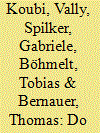

|
|
|
|
|
| Publication |
2014.
|
| Summary/Abstract |
This article reviews the existing theoretical arguments and empirical findings linking renewable and non-renewable natural resources to the onset, intensity, and duration of intrastate as well as interstate armed conflict. Renewable resources are supposedly connected to conflict via scarcity, while non-renewable resources are hypothesized to lead to conflict via resource abundance. Based upon our analysis of these two streams in the literature, it turns out that the empirical support for the resource scarcity argument is rather weak. However, the authors obtain some evidence that resource abundance is likely to be associated with conflict. The article concludes that further research should generate improved data on low-intensity forms of conflict as well as resource scarcity and abundance at subnational and international levels, and use more homogenous empirical designs to analyze these data. Such analyses should pay particular attention to interactive effects and endogeneity issues in the resource-conflict relationship.
|
|
|
|
|
|
|
|
|
|
|
|
|
|
|
|
| 3 |
ID:
168439
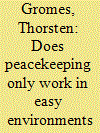

|
|
|
|
|
| Summary/Abstract |
Peacekeeping is widely considered to be an effective means of preventing civil war recurrence. However, as peace has collapsed in a considerable number of cases despite peacekeeping efforts, we are left with the question which combinations of peacekeeping environments and peacekeeping missions lead to lasting peace. This article compares 22 peacekeeping missions between 1990 and 2012. While prominent United Nations documents assume that the success of post-conflict peacekeeping primarily depends on the features of the mission itself, the analysis shows that characteristics of the terminated civil war have a strong influence on whether peace endures. Restrained peacekeeping, defined by low troop density, non-robustness, and a lead nation that is not a permanent member of the Security Council, only succeeds in preserving peace in conducive environments. Inconclusive war endings, evenly distributed military capabilities at war’s end, ethnic conflicts, and high intensity create a particularly difficult context for peacekeeping.
|
|
|
|
|
|
|
|
|
|
|
|
|
|
|
|
| 4 |
ID:
126444
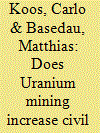

|
|
|
|
|
| Publication |
2013.
|
| Summary/Abstract |
We investigate whether uranium, similar to other resources, is associated with armed conflicts. The analysis uses grid cells in Africa to test this hypothesis. Results from logistic regressions reveal that uranium operations are not an independent conflict risk; however, it is significantly linked to local conflict events when interacting with ethnic exclusion. The analysis is supplemented by process tracing in four countries, where armed conflict broke out after uranium operations started (DR Congo, Central African Republic, Niger and South Africa). We find substantial evidence for a link only in the case of Niger. Our results suggest that uranium promotes intrastate conflict only under specific circumstances.
|
|
|
|
|
|
|
|
|
|
|
|
|
|
|
|
| 5 |
ID:
137423
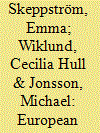

|
|
|
|
|
| Summary/Abstract |
With European Union Training Missions (EUTM) Mali and EUTM Somalia, the EU seeks to stabilize countries facing state weakness caused by intrastate conflict. While the EU formally promotes security sector reform (SSR) through its foreign policy, the EUTM missions in Mali and Somalia in one sense can be described as “counter-insurgency by proxy” as military trainees combat local insurgencies shortly upon graduation. This raises the question whether the EUTM missions are consistent with SSR aims, such as creating a security sector that is legitimate, sustainable, and under civilian control, or inadvertently risk contributing to negative side effects in the medium term. Based on extensive interviews in Belgium, Kenya, Mali, Sweden, and Uganda with personnel who either served in or planned these missions, this study analyses factors which hinder the EUTM concept from being fully consistent with SSR and identifies possible policies to ameliorate the risk of unintended side effects.
|
|
|
|
|
|
|
|
|
|
|
|
|
|
|
|
| 6 |
ID:
097085


|
|
|
| 7 |
ID:
134155
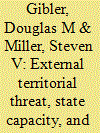

|
|
|
|
|
| Publication |
2014.
|
| Summary/Abstract |
We argue that the regional threat environment a state faces plays a consequential role in its political development and the likelihood of experiencing future intrastate wars. Challenges to a state's territorial integrity lead governments to increase their military personnel, and the resources that support these increases most often come willingly from a public that seeks security. Territorial threats are unlike other types of threats because they challenge individual lives and livelihoods, which both connects the average citizen with the state and allows for easier government extraction of necessary resources. Thus, external territorial threats increase state capacity by unifying the state and by increasing the repressive power of the central government. We identify territorial threats as both latent and realized claims against state territories and find that the presence of an external threat to territory leads to an increase in the capacity of central governments to connect and extract from its citizens, as well as the capacity to repress potential regime dissidents. We also find that the presence of a claim against a state's territory from a neighbor corresponds with a substantial decrease in the likelihood of intrastate conflict at both high and low levels of intensity. The effect of territorial threat is observed even in the short term after a territorial threat has been resolved. Our tests, using standard models of state capacity and insurgency models of conflict on a sample of all states from 1946 to 2007, are robust to multiple model specifications.
|
|
|
|
|
|
|
|
|
|
|
|
|
|
|
|
| 8 |
ID:
160475
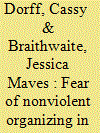

|
|
|
|
|
| Summary/Abstract |
What drives perceptions of fear regarding nonviolent mobilization? We investigate whether this fear is more acute in certain segments of society, or whether such concerns are randomly distributed across the population. We anticipate that civilians living in proximity to armed resistance groups are especially afraid of being targeted if they organize nonviolently against insecurity in their community. Using original survey data from Mexico in early 2014, we examine civilian perceptions of risk associated with nonviolent action. Quantitative analyses provide support for our expectation that civilians living in proximity to armed vigilante groups are more fearful of participating in nonviolent action. This suggests that organizers of civil resistance in Mexico (and similar conflict environments) would do well to consider the challenges posed by civilian vigilantism when seeking to mobilize civilians and selecting specific nonviolent strategies for high-risk constituencies.
|
|
|
|
|
|
|
|
|
|
|
|
|
|
|
|
| 9 |
ID:
173772
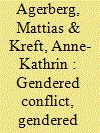

|
|
|
|
|
| Summary/Abstract |
Sexual violence (SV) in conflict is increasingly politicized at both the international and domestic levels. Where SV in conflict is prevalent, we argue international actors perceive gender to be salient and push for a gendered response. Simultaneously, women mobilize politically in response to the threat to their security that conflict-related SV constitutes, making demands for greater representation in politics with the goal of improving societal conditions for themselves. Jointly, we theorize the pressures from above and below push governments in conflict-affected states toward adopting gender policies. We test this theoretical framework in the case of gender quota adoption. We find that states with prevalent wartime SV indeed adopt gender quotas sooner and at higher rates than states experiencing other civil conflicts and than states experiencing no conflict in the same period. These gender quotas, we further show, are not mere window dressing but actually increase women’s legislative representation.
|
|
|
|
|
|
|
|
|
|
|
|
|
|
|
|
| 10 |
ID:
141471
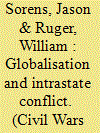

|
|
|
|
|
| Summary/Abstract |
How does globalisation, especially foreign direct investment, influence the risk of intrastate conflict? While several prominent studies have found that globalisation reduces the probability of civil war, we use new data and methods to approach the question. In particular, we test for the possibility that foreign investment is endogenous to conflict risk and appropriately use inward foreign investment stock rather than net inflow to measure an economy's exposure to international capital markets. We find no evidence that foreign investment affects civil conflict, suggesting that governments' fundamental security interests trump the economic losses they can expect to suffer from failing to compromise with potential rebel groups.
|
|
|
|
|
|
|
|
|
|
|
|
|
|
|
|
| 11 |
ID:
165449
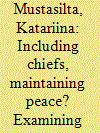

|
|
|
|
|
| Summary/Abstract |
The continued influence of traditional governance in sub-Saharan Africa has sparked increasing attention among scholars exploring the role of non-state and quasi-state forms of governance in the modern state. However, little attention has been given to cross-country and over-time variation in the interaction between state and traditional governance structures, particularly in regard to its implications for intrastate peace. This study examines the conditions under which traditional governance contributes to state capacity to maintain peace. The article argues that the type of institutional interaction between the state and traditional authority structures influences a country’s overall governance dynamics and its capacity to maintain peace. By combining new data on state–traditional authorities’ interaction in sub-Saharan Africa from 1989 to 2012 with intrastate armed conflict data, I conduct a systematic comparative analysis of whether concordant state–traditional authorities’ interaction strengthens peace. The empirical results support the argument that integrating traditional authorities into the public administration lowers the risk of armed conflict in comparison to when they remain unrecognized by the state. Moreover, the analysis suggests that the added value of this type of interaction is conditional on the colonial history of a country.
|
|
|
|
|
|
|
|
|
|
|
|
|
|
|
|
| 12 |
ID:
110419
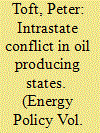

|
|
|
|
|
| Publication |
2011.
|
| Summary/Abstract |
In this paper I investigate how often and how much outbreaks of intrastate conflict in oil producing states translates into oil supply shortfalls. The Libyan conflict that broke out in February 2011 highlighted the fear that intrastate conflict in oil producing states may imply shortfalls and ensuing volatile global oil prices. I argue, however, that it is far from certain that shortfalls following conflict outbreak will occur, since both sides in a conflict face incentives simultaneously to protect and maintain oil installations and to strike and destroy these. Based on a quantitative analysis of 39 intrastate wars in oil producing countries (1965-2007) I conclude that outbreak of conflict does not translate into production decline with any certainty. In fact, likelihoods are less than 50% for reductions to occur. In many cases growing production actually followed conflict outbreak. I conclude by investigating four characteristics of intrastate conflict that may explain when oil production is at risk during conflict: (1) proximity of oil producing fields to key battle zones, (2) duration of conflict, (3) separatism and the location of oil in separatist territory, and (4) the relative size of oil production. While the first three factors did not prove important, oil producer size could be significant. But further research is needed to establish this with greater certainty.
|
|
|
|
|
|
|
|
|
|
|
|
|
|
|
|
| 13 |
ID:
162767


|
|
|
|
|
| Summary/Abstract |
Machine-coded event datasets have become popular in conflict research. I argue that systematic media biases render news-based event data unsuitable for studying networks of insurgents and political parties. Insurgent networks are too secretive to be captured by media reports, whereas alliances among regular political parties are too constant to be considered newsworthy. I analyze the data accuracy of the network study of insurgents and political parties in Thailand by Metternich et al. (2013), which is based on the most comprehensive event dataset currently available: Lockheed Martin's International Crisis Early Warning System (ICEWS) project. Using simple evaluation criteria, I show that most of the network data entries are incorrect, leading to a depiction of the networks that is unrelated to real-world cleavages in Thailand. While my hand-coded event dataset captures relatively more network-relevant information than ICEWS, the comparison confirms that journalists specifically underreport cooperative events among insurgents and parties. In addition, the ICEWS project provides unreliable counts of conflictual events in Thailand. Using alternative conflict measurements from the Deep South Watch dataset and a dummy variable based on established periods of unrest, I show that violent activities in Thailand's Deep South declined during periods of conflict between pro- and anti-Thaksin groups. Conflicts were unrelated to network fragmentation, contradicting the primary finding of Metternich et al.
|
|
|
|
|
|
|
|
|
|
|
|
|
|
|
|
| 14 |
ID:
173635
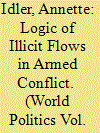

|
|
|
|
|
| Summary/Abstract |
Why is there variation in how violent nonstate groups interact in armed conflict? Where armed conflict and organized crime converge in unstable regions worldwide, these groups sometimes enter cooperative arrangements with opposing groups. Within the same unstable setting, violent nonstate groups forge stable, long-term relations with each other in some regions, engage in unstable, short-term arrangements in others, and dispute each other elsewhere. Even though such paradoxical arrangements have intensified and perpetuated war, extant theories on group interactions that focus on territory and motivations overlook their concurrent character. Challenging the literature that focuses on conflict dynamics alone, the author argues that the spatial distribution of illicit flows influences how these interactions vary. By mapping cocaine supply chain networks, the author shows that long-term arrangements prevail at production sites, whereas short-term arrangements cluster at trafficking nodes. The article demonstrates through process tracing how the logic of illicit flows produces variation in the groups’ cooperative arrangements. This multiyear, multisited study includes over six hundred interviews in and about Colombia’s remote, war-torn borderlands.
|
|
|
|
|
|
|
|
|
|
|
|
|
|
|
|
| 15 |
ID:
148047


|
|
|
|
|
| Summary/Abstract |
Historically, insurgency is one of the most prevalent forms of armed conflict and it is likely to remain common in the foreseeable future. Recent experiences with counterinsurgency in Iraq and Afghanistan offer many lessons for future counterinsurgents, but the discourse on the subject continues to be mired in a traditional dichotomy pitting population-centric approaches to counterinsurgency against enemy-centric approaches. Historical analysis suggests that this traditional dichotomy is not a sufficiently nuanced way to understand or plan for such operations. Instead, discussions of counterinsurgency should focus on two dimensions: actions (use of physical force vs. political or moral actions) and targets (active insurgents vs. insurgent support). This perspective divides the space of possible counterinsurgency efforts into four quadrants, suggesting that effective counterinsurgency campaigns find a balance of effort across the four quadrants that is well matched to the specific context.
|
|
|
|
|
|
|
|
|
|
|
|
|
|
|
|
| 16 |
ID:
148323
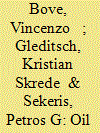

|
|
|
|
|
| Summary/Abstract |
We explore economic incentives for third parties to intervene in ongoing internal wars. We develop a three-party model of the decision to intervene in conflict that highlights the role of the economic benefits accruing from the intervention and the potential costs. We present novel empirical results on the role of oil in motivating third-party military intervention. We find that the likelihood of a third-party intervention increases when (a) the country at war has large reserves of oil, (b) the relative competition in the sector is limited, and (c) the potential intervener has a higher demand for oil.
|
|
|
|
|
|
|
|
|
|
|
|
|
|
|
|
| 17 |
ID:
106354
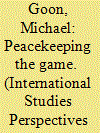

|
|
|
|
|
| Publication |
2011.
|
| Summary/Abstract |
Political science students face the difficult challenge of understanding the obstacles to resolving intrastate conflict. Often, instructors will use negotiation-based role-playing simulations to model arduous discussions between the warring groups and intervening parties. However, the long-term challenges of directing peacebuilding and ensuring security are equally important parts of intrastate conflict resolution that remain unaddressed in current simulations. The design of simulations with board-game-like rules for teaching about intrastate conflict has also been unexplored. This paper lays out a new type of simulation with board-game-like rules that present realistic obstacles to students as they try to balance the various needs of their assigned state. A detailed discussion of the significance of each of the game rules and potential applications of the simulation is included.
|
|
|
|
|
|
|
|
|
|
|
|
|
|
|
|
| 18 |
ID:
188083
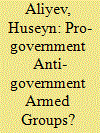

|
|
|
|
|
| Summary/Abstract |
This study challenges the presentation of non-state armed groups as divided into anti-government rebels and pro-government proxies and proposes that some pro-government armed groups maintain explicit anti-government rhetoric. It is this anti-government agenda that enables “pro-government” groups to successfully recruit their members and to advance their interests. From Iraq’s Shiite militias to Lebanon’s Hezbollah and Afghan Uzbek warlords, there are numerous armed groups which, on the one hand, officially maintain pro-government stance and, on the other hand, explicitly criticize, oppose and challenge the state. On a theoretical level, this study seeks to demonstrate that a “pro-government anti-government” group is a distinct category of non-state armed groups that neither directly engages in armed confrontation with the state nor complies with its agenda and policies or fully accepts its legitimacy. On an empirical level, this paper explores why individuals mobilize for pro-government anti-government armed groups. Unique micro-level interview data with members of volunteer militia battalions in Ukraine are employed to provide insights into the functioning of pro-government anti-government militants. Drawing upon its empirical findings, this study proposes that pro-government “government challengers” emerge and persist because these groups are more efficient than the government in the provision of security and in promoting the incumbent’s ideology.
|
|
|
|
|
|
|
|
|
|
|
|
|
|
|
|
| 19 |
ID:
089496
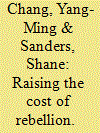

|
|
|
|
|
| Publication |
2009.
|
| Summary/Abstract |
This paper presents a simple model to characterize explicitly the role that an intervening third party plays in raising the cost of rebellion in an intrastate conflict. Extending the Gershenson-Grossman (2000) framework of conflict in a two-stage game to the case involving outside intervention in a three-stage game as in Chang et al. (2007b), we examine the conditions under which an outside party optimally intervenes such that (i) the strength of the rebel group is diminished or (ii) the rebellion is deterred altogether. We also find conditions in which a third party optimally intervenes but at a level insufficient to deter rebellion. Such behavior, which improves the incumbent government's potential to succeed in conflict, is overlooked in some conflict studies evaluating the effectiveness of intervention. One policy implication of the model is that an increase in the strength of inter-governmental trade partnerships increases the likelihood that third-party intervention deters rebellion.
|
|
|
|
|
|
|
|
|
|
|
|
|
|
|
|
| 20 |
ID:
178682
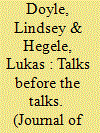

|
|
|
|
|
| Summary/Abstract |
Pre-negotiation is widely accepted as a means to convince intrastate conflict parties to negotiate formally; however, research has not yet established a causal link between early efforts to bring warring parties together and the outcome of any negotiated settlement. This gap begs the question: To what extent do activities during the pre-negotiation phase contribute to the signing of a peace agreement? Theory on interstate conflict suggests that pre-negotiation reduces risk, thereby convincing conflict parties that they have more to gain from negotiating than from fighting. However, in conflicts between governments and non-state armed actors, this article argues that reciprocity paves the way for reaching peace agreements. This article introduces a new dataset on pre-negotiation including nearly all intrastate armed conflicts between 2005 and 2015. Confirming previous findings, mediation is significantly and positively correlated with reaching a type of peace agreement; conflicts over government are more likely to end in a negotiated agreement than conflicts over territory or both government and territory. In contrast to existing qualitative research, this study finds little evidence that pre-negotiation increases the likelihood that conflict dyads sign peace agreements. Future quantitative research on this topic requires more nuanced measures of the conditions under which conflict parties shift from unilateral to joint decisionmaking.
|
|
|
|
|
|
|
|
|
|
|
|
|
|
|
|
|
|
|
|
|